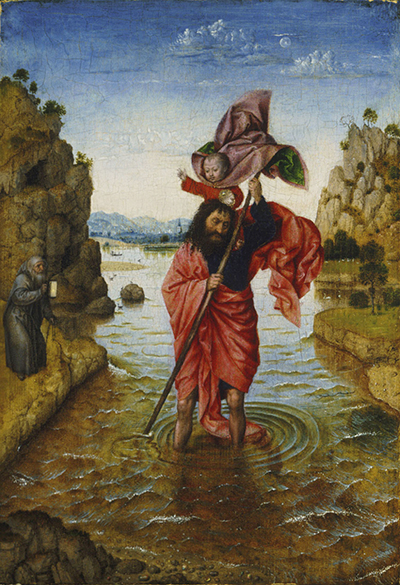Saint Christopher is one of several artworks attributed to Jan van Eyck that have since been lost in the centuries that have passed since his career took hold. The brilliance of the original painting led to many copies being made by other notable artists, which is how we can provide an accurate summary of how it would have looked.
Greats of their time such as Dieric Bouts and Hans Memling are known to have featured their own take on this painting within their careers, along with a number of other less famous artists who were astounded and inspired by Van Eyck's work in equal measure. Jan van Eyck was unusual in that he provided innovative artists styles whilst still managing to achieve considerable success within his own lifetime, which is relatively rare within the history of art. His sucess was perhaps down to his use of existing methods, but innovating new techniques within them, so as not to evolve too suddenly in a way that upset the more conservative minds. Whilst we know most about how it would have looked from a copy in the collection of the Philadelphia Museum of Art, there was also a drawing produced of it which now resides within the Louvre in Paris.
The composition itself features a huge bearded man carrying a young child on his shoulders whilst he navigates his way through water that laps around his ankles, forcing him to use a stick to drag himself forwards through the waves. St Christopher is known to be the patron saint of travellers, and the symbolic suggestion of this painting is that he carries the considerable weight of the world on his back. There is a globe in the child's hand to represent the world itself and we believe that the child actually represents Christ, someone who featured regularly within Van Eyck's career, with so much of it based on religious themes. At this time, most artists would seek commissions from the highest paying and most powerful patrons, and most of them would be connected to the church in some way or other, hence the abundance of religious paintings that appeared at this time.
The Philadelphia Museum of Art, which holds the copy that is displayed on this page, also offers a wide selection of work from other notable artists. They have actually loosely dated this piece at around 1460 and in most cases the paintings held by major art institutions such as this are best placed to find the resources needed to learn as much as possible about the items in their collections. Normally it is the privately owned pieces that remain more of a mystery, with far less interest in learning more about their past for the owners. Visitors to see the excellent copy with also be interested in some of the more high profile items to be found here, such as Epiphany by Hieronymus Bosch, Crucifixion Diptych by Rogier van der Weyden, J.M.W. Turner's The Burning of the Houses of Lords and Commons and also the iconic Sunflowers, Arles, 1889 by Vincent van Gogh.




